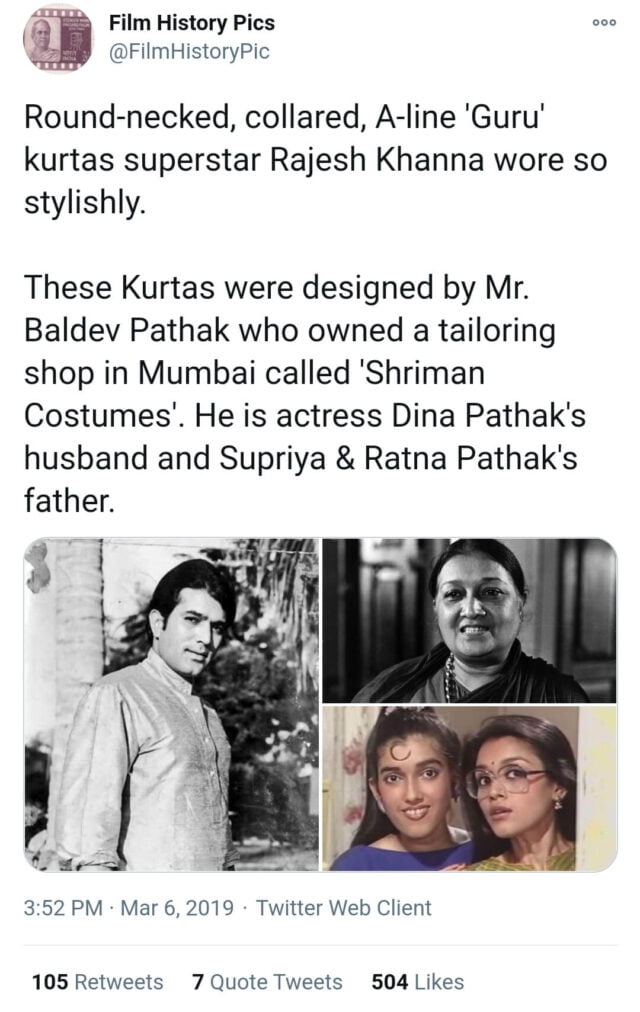Rajesh Khanna was not only an actor but much more. A hero, a politician, a hopeless romantic in love with Dimple Kapadia, and a doting father. He was also the man who taught us that life should be big, not long.
He was the only actor to give 15 consecutive solo hits between 1969 and 1971, feels surreal, huh? He was one of a kind.
People were not only interested in his movies and personal life. His lifestyle also did not fail to catch the attention of his fans, starting from his bungalow, MG sports car to his love for mithai and paan. There is one more thing that has been the talk of the town for decades now: the famous guru kurta.
What Is So Different About Guru Kurtas?
Can you believe that a kurta could have inspired generations and generations of fashion designers? You have to when it is associated with none other than the late superstar, Rajesh Khanna!
Along with his iconic head nod, his slo-mo squinting of eyes, and a touching smile, his guru kurta also became something the young males aped from him.
We all are aware of Indian kurtas, right? The desi menswear worn by the richest of the rich and the poorest of the poor, kurtas to Indian wear is like salt to food, one may claim. Now you can ask what is so special about this guru kurta. To understand it, we have to go back in time.
Guru kurtas are basically collared A-line kurtas with round necks and rolled back sleeves, but now they have a stamp of glamour on them. Initially, they were just kurtas worn by poor farmers and humble politicians in the 1960s and 70s. However, these kurtas created a trend out of a common man’s attire.

Also Read: Behind The Famous Indian Lyricist Of All Time, Here Are Few Things You Should Know About Gulzar
The guru kurtas for Rajesh Khanna were designed by Mr. Baldev Pathak, Supriya and Ratna Pathak’s father. He owned a tailoring shop in Mumbai known as Shriman Costumes.
Did Guru Kurtas Change Anything?
Bandhan, Do Raaste, Doli (all 1969); The Train, Aan Milo Sajna (both 1970); Chhoti Bahu, Haathi Mere Saathi, Mehboob Ki Mehndi (all 1971) redefined the street fashion with an air of Rajesh Khanna’s personality.
The guru kurta also added to his personality. It showed a mix of defiance and romantic pedagogy at the same time.
It was also one of the prime favourites of the costume designers as putting a kurta seemed to be the only smart choice to hide a growing waistline, which seems to be a fan repeller even today in Bollywood.
Rajesh Kumar’s fans were not limited to a single class or crowd. They belonged to various walks of life with diverse identities.
It amplified the consequences of his trend of wearing guru kurtas. What was earlier worn by a section of the society now became a fashion statement for all.
Such was the craze for the kurta that it continues to be in fashion since the 1960s.
How Did The Guru Prefix Come Into Being?
The answer lies in the round neck. These kinds of the neck were more common among the people who had a spiritual inclination or were spiritual leaders, commonly known as a guru in India. Adding to that, Rajesh Kumar’s charm made the prefix guru an essential addition to the brand.

When seen from a narrow perspective, it is just a type of kurta made fashionable by Rajesh Khanna. But once you try to understand the bigger picture here, the profound repercussions of this Indian attire in vogue start getting clearer.
Image Credits: Google Images
Sources: The Indian Express, The Times of India, The Hindu
Find The Blogger: @soumyaseema
The post is tagged under: Rajesh Khanna, Guru Kurta, Birthday, farmers, humble politics, Congress, Shriman costumes, class divide, personality, style icon, defiance and romance, lifestyle, guru, Indian kurta, trend, vogue, fashion
Other Recommendations:
Watch: Unsuccessful Bollywood Actors Who Are Products Of Nepotism































password please